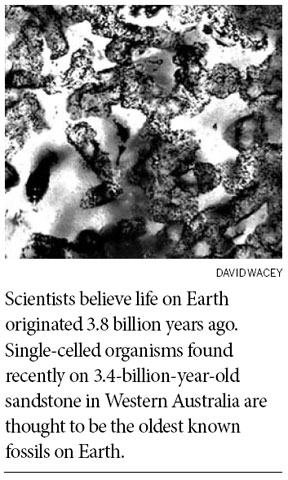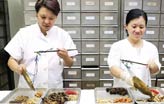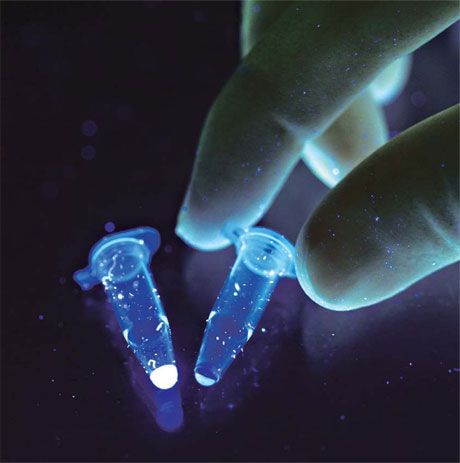Society
For life out there, start here
Updated: 2011-08-28 07:59
By Dennis Overbye (The New York Times)
|
Scientists have developed a molecule in a test tube that replicates and evolves by itself. Jim Wilson / The New York Times |
San Diego, California
Generations of scientists and science fiction fans have grown up presuming that humanity's first encounter with alien life will happen in outer space.
But it could soon happen right here on Earth, according to a handful of chemists and biologists who are using modern genetics to try to create life in a test tube. By some measures, Gerald F. Joyce, a professor at the Scripps Research Institute here, has already crossed that line.
Biologists do not agree on what the definition of life should be or whether it is even useful to have one. But most do agree that the ability to evolve and adapt is fundamental to life. And they also agree that having a second example of life could provide insight to how it began and how special life is or is not in the universe, as well as a clue for how to recognize life if and when we do stumble upon it out there.
Dr. Joyce said recently: "It drives me crazy when astronomers say, 'Surely the universe is pregnant with life.' If we have an Earthlike planet, what are the chances of life arising? Is it one in a million? Is it one in two? I don't see how you can say."
He continued, "If you had a second example of life, even if it were synthetic, you might know better. I'm betting we're just going to make it."
Four years ago Dr. Joyce and a graduate student, Tracey A. Lincoln, now a researcher at the University of Massachusetts Medical School, evolved a molecule in a test tube that could replicate and evolve by itself forever, given the right ingredients.
Dr. Joyce's molecule is a form of RNA, or ribonucleic acid, that assembles proteins in accordance with the blueprint encoded in DNA. Neither RNA nor DNA is alive by itself. But in Dr. Joyce's test tube, his specially engineered RNA molecule comes close, copying itself over and over, and evolving.
Reproduction is the job of any life, Dr. Joyce explained, but Earthly organisms have evolved tricks to improve the odds of success " everything from peacock feathers to whale songs. Dr. Joyce's molecules have not " yet .
But it is only a matter of time, he said, before they do.
The philosophical and intellectual ramifications of test tube life are enormous. The achievement would probably not come with sci-fi drama, some scientists say. Indeed, it could be years before everybody agrees it has been done.
"The ability to synthesize life will be an event of profound importance, like the invention of agriculture or the invention of metallurgy," Freeman Dyson, a mathematician and physicist at the Institute for Advanced Study in Princeton, New Jersey, wrote in an e-mail.
On Earth, all life as we know it is based on DNA, the carbon-based molecule that contains the instructions for making and operating cells in a four-letter alphabet along its double-helix spine.
The possibilities of a second example of life are vast. It could be based on DNA that uses a different genetic code; it could be based on some complex molecule other than DNA; or even some kind of chemistry based on something other than carbon, like phosphorous or iron. Others wonder whether chemistry is necessary at all. Could life manifest itself in the pattern of electrically charged dust grains in a giant interstellar cloud, as the British astronomer Fred Hoyle imagined in his novel "The Black Cloud"?
So far, Dr. Joyce said, his work with Dr. Lincoln has shown that manmade molecules can evolve over successive generations. "They can pass information from parent to progeny, they can mutate," Dr. Joyce said.
All sorts of alternatives are being explored in other labs.
 |
Some researchers, like Steven Benner of the Foundation for Applied Molecular Evolution in Florida, are constructing and experimenting with forms of DNA that use coding alphabets of more than four letters. J. Craig Venter, who helped spearhead the decoding of the human genome and now works as president of the J. Craig Venter Institute, recently used store-bought chemicals to reconstruct the genome of a bacterial goat parasite and put it in another bacterium, where it took over, churning out copies of itself.
George Church and Farren Isaacs of the Harvard Medical School recently reported that they had reprogrammed the genome of an E. Coli bacterium, opening up the possibility of incorporating new features into it. Dr. Joyce called the work "really macho molecular biotechnology."
Jack Szostak of Harvard Medical School and his collaborators have embarked on an ambitious project to build an artificial cell that can replicate and presumably evolve.
Scientists believe that life on Earth originated about 3.8 billion years ago. The first inhabitant, chemists suspect, was RNA.
(On August 22, The Times reported that a team of Australian and British geologists had discovered fossilized, single-cell organisms 3.4 billion years old that the scientists say are the oldest known fossils on Earth. The fossils were found in sandstone at the base of the Strelley Pool rock formation in Western Australia.)
Today, RNA runs errands for DNA. Like DNA, RNA encodes genetic information. Unlike DNA, however, RNA can also catalyze chemical reactions between other molecules, chopping them up or binding them together, a task mostly performed by proteins in modern organisms.
In 1962, Alexander Rich, a biologist at the Massachusetts Institute of Technology, suggested that RNA could have played both roles at the beginning. Scientists cannot prove that this is how life arose on Earth, but they can make their own RNA and see if they can then breathe life into it.
In 2002, Dr. Joyce and a postdoctoral fellow, Natasha Paul, configured a molecule to recognize and glue together a pair of smaller molecules. When joined, those molecules would form a new copy of the original T-shaped molecule. It worked; the RNA manufactured new versions of itself, but not fast enough to keep up with the original RNA's natural tendency to fall apart: it was dying faster than it was reproducing. Dr. Joyce found a way to speed the process up, by having two complementary versions of the RNA manufacture each other.
On October 1, 2007, the replicators "went critical," as he put it, and their population began growing exponentially.
Dr. Joyce's team has synthesized 12 versions of the replicators, which could mutate and evolve to improve their ability to reproduce. They threw these into the pot, with the appropriate "food," to compete.
By the end, the winning molecules were doubling their numbers every 15 minutes. Mistaken swaps produced mutations. Most of the original versions almost completely disappeared. In short, the molecule evolved.
In a separate experiment the molecules were redesigned so they would replicate only when another chemical was present. "That's the app that's going to pay for this," said Dr. Joyce, explaining that the replicating molecules could be fashioned to detect pollutants or dangerous toxins in the environment. Dr. Joyce's team is now starting to run the same tournament with 256 versions of the replication enzyme.
That means that about 65,000 possible gene combinations could emerge. As Dr. Lincoln said, "We're knocking on the door, but we're not quite there yet." Sidney Altman, a professor at Yale University who shared a Nobel prize for discovering some of the talents of RNA, said that true test tube life could still be years away. "Gerry Joyce's replicators are very clever molecules," he said, but added that they were not self-sufficient enough to be alive.
Asked for an example of what he could teach his RNA to do, Dr. Joyce suggested it could take part in creating one of the ingredients for its own replication by adding together a pair of smaller molecules. The key to more ability, he said, is complexity. His molecule has only two genes, compared with 25,000 in human beings, and experiments involved four letters of these genes. The human genome has three billion letters.
"We have a little toy genome where we can have the complete book of life," he said, "but the sentences only have two words."
But someday Dr. Joyce's genome may surprise their creator with a word that he has not anticipated. "If it would happen, it would do it for me, I would be happy," Dr. Joyce said, adding, "I won't say it out loud, but it's alive."
The New York Times

Specials

Flying the TCM flag
A small German town is home to Europe's flagship clinic for traditional Chinese medicine

Hunting grounds
Opinion divided as China debates opening door to international players

Animal attraction
World's youngest chief fur designer set to launch own label and tap into huge China market.
